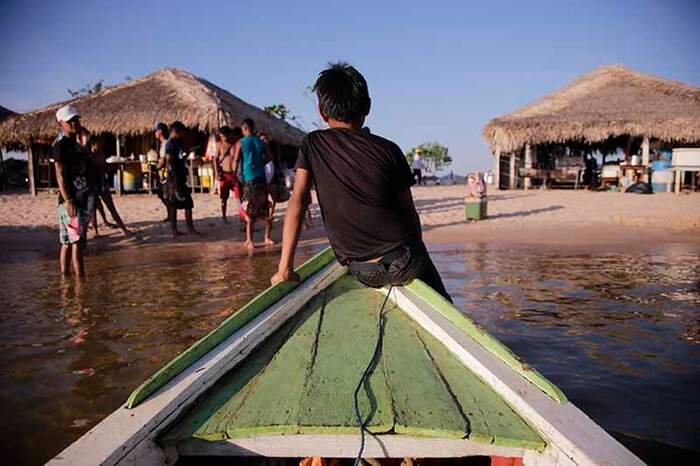In the west of Pará, the region of Santarém is expecting to recover the touristic power
After a 65% drop in movement in 2020, operators and local authorities are preparing to a resumption, betting on nature and community-based tourism
Breakfast at the table, employees working at full steam and guests waking up to the sound of monkeys and birds that inhabit the forest. This is how the day begins at one of the dozens of inns in Alter do Chão, in Santarém. The scene is quite different from the same period last year, when the pandemic's toughest restrictive measures prevented the arrival of tourists in the city. In 2020, the retraction reached 65% of that registered in 2019, before the health crisis.
Listen to the comment on this news:
In “normal” times, Santarém receives around 200,000 tourists a year, moving more than R$150 million, according to an estimate by the city hall. Now, with the advance of vaccination and the reduction of restriction measures, the expectation of the tourism sector is to recover a little of the lost year, initially returning to the numbers of 2019 and, for 2022, in a more favorable scenario, to return to growth as a destination for Brazilians and foreigners who want to know more about the different (and beautiful) scenarios of the Amazon.
“Tourism here is basically about sun and beach. But, we have community-based tourism as a growing one in Santarém; religious tourism; and events such as Çairé, a manifestation that mixes religious and profane elements, of indigenous and Portuguese origins, responsible for bringing 50 to 60 thousand people every year in September. It is also a nature destination, this is the trend in the post-pandemic, people want to go to the forest and discover the Amazon. The greatest beauties in Pará are in this area. So we are going to be able to take off, taking advantage of these characteristics”, comments the municipal secretary of Tourism, Alaércio Cardoso.
Opposite at the political level, the federal and state administrations have been investing in the region, generating a healthy dispute, which guarantees more equipment and infrastructure to boost local tourism. In early August, the city received on the same day the minister of Tourism, Gilson Machado, representing the government of Jair Bolsonaro, and the governor of Pará, Helder Barbalho.
From the federal level, the outstanding works total R$ 7 million, which include the Orla da Praia do Maracanã, the refurbishment of Praça do Çairé, in Alter do Chão, and the urbanization of the Orla da Vila Arigó, all in the same region and that help to improve the tourist infrastructure. Under the state management, the contributions are more robust and include a large water port in Santarém – expected to be completed by the end of the year. The construction of a Convention Center to boost business tourism is also already authorized. Added together, there are more than R$ 120 million in investment in the sector.
For the head of the Secretary of State for Tourism (Setur), André Dias, the center will change the reality in Santarém for good. “The large congresses are moving from urban centers to areas with greater tourist and leisure potential. Our attractiveness here is sensational. The space extends people's stay, and this is a goal, combining business and leisure tourism”.
A destination and many scenarios throughout the year
The “Santareno” tourism is much stronger in periods when the beaches of Alter do Chão, an island that is 30 minutes from the city, have a strip of sand - when the Tapajós River is at its driest stage, from September to January. In this period of “low season”, airline tickets are cheaper. The savings in your pocket, however, are not repeated in the options for destinations and tours. Throughout the year, the destination deserves to be visited at different times. The same place can have completely varied and dazzling scenarios – and experiences.
Even with the waters of the Tapajós reaching much greater heights during the rainy season, the region offers surprising charms for those who know it between February and August. Some trips, made by canoe, are only possible when the island is flooded. One of them is the Enchanted Forest, which is just a few kilometers from the edge of Alter do Chão. It is possible to go by speedboat to the access channel and then take a canoe to explore the forest in a 30-minute ride. During drought, visitors need to make the route on foot, since there is no water at this point. A potential that has been increasingly explored.
Five reasons to include Santarém in your next travel plan:
1. Meeting of the waters
Going to Rio de Janeiro and not visiting Cristo Redentor is almost disrespectful. In Santarém, the same can be said of one of the city's “trademarks”: the meeting of the waters of the Tapajós and Amazonas rivers, in front of the city. It can be seen from several restaurants and bars on the waterfront. Tapajós is born in Mato Grosso and bathes part of Pará and Amazonas. It is 1.5 thousand kilometers long and covers 6% of the Amazon basin. The Amazonas, on the other hand, is the longest river in the world, with 7 thousand kilometers in length, running through much of northern South America, flowing into the Atlantic Ocean.
The two rivers do not mix due to density, temperature and speed. Residents poetize this phenomenon. It is common to hear from tourist guides that the reason is not natural, but there is a feeling involved: the clear, blue-green waters of the Tapajós “protect” the city from the muddiest waters of the Amazonas. To see the phenomenon, just take a boat on the edge of Santarém, at the Tourist Fluvial Terminal (TFT).
2. Pindobal Beach
Less than 40 kilometers from Santarém, the city of Belterra has one of the most popular beaches in western Pará: Pindobal. In the first days of the week, the place is almost empty. From Wednesdays onwards, it starts to get more agitated. The peak of bathers takes place on Sundays.
From Belterra, access to Pindobal is by road, 12 kilometers from the city. For those in Alter do Chão, it is possible to go by land transport, covering 7 kilometers, or by speedboat. The straw-covered tents are the difference, with full meals and various types of drinks. The beach is in a kind of “curve” in the river, and the sunset is an attraction in itself. Whether staying in Santarém, Alter or Belterra, the destination does not go unnoticed.
3. Island of Love
In Alter do Chão, the “Ilha do Amor” is the main beach in the region. It's right in front of the city's edge and can be seen from any point. Even in the flood period, the Ilha do Amor doesn't disappear completely – the tops of the tents are still exposed, indicating that there, under all that amount of water, there is a hidden natural beauty, about to come to the surface. When the beach reappears, the landscape is spectacular. The waters are crystal clear and have a pleasant temperature and the scenery has already been called the “Amazon Caribbean” by the international press.
To cross to Ilha do Amor, just take a speedboat or even a canoe on the shore. It's a five-minute crossing. Tourists already arrive on the sand to spend the afternoon on the island, eating fish that are featured on the menus of all restaurants.
4. Trail of Sloth
In Alter, among the most distant places – and not so famous yet – is the “Trilha da Preguiça”, which is located at the back of a house in the middle of the waters that fill the region. Just an hour by boat, leaving from Canal do Jari. Maria Rosângela Pinto, 62, has been offering the tour for a decade.
Departing from her house, she herself leads groups in canoes. Paddling along the forest paths, she talks about the Amazon beauties and animals that inhabit trees, some with more than 200 years old. It is possible to see different species of birds, which sing and make unique noises; monkeys hanging from trunks; and snakes coiled from the highest branches. And the name of “baptism” of the trail is also present: it is almost always possible to observe sloths moving calmly.
5. Armadillo Burrow
One of the greatest cultural movements in Alter do Chão is celebrated there: the carimbó. From Thursday to Sunday, the place is full of tourists, attracted to get to know the region's artists better. In the simple terrain, a stage is set up, where singers, musicians and dance groups make presentations.
Several booths with sellers present their products: clothes, accessories and drinks for visitors. There are tables and chairs for those who want to follow the shows more comfortably, but there is no lack of space in the middle of the lot, in front of the stage, for those who try to take risks and learn carimbó alongside dancers, including women who run long and flowery skirts.
From generation to generation...
Cultivating and spreading Amazon culture is one of the challenges for those who live in Baixo Tapajós. Many who work with their own businesses use creativity to explore the difference in the region, following in the footsteps of their parents to generate income at home.
This is the case of Hinho Moreno, 45, and his wife, Sandra Moreno Clemente, 34. He grew up in the Nova Vista community, in Alto Tapajós. Sandra has a Spanish family and grew up in the city of Valencia. Before arriving in Alter do Chão, she had spent eight years traveling the world and selling handicrafts.
Even with such different realities, the two were united by carimbó and sewing. Hinho was passionate about sewing and practiced since he was 10 years old, inspired by his mother. Sandra sewed for leisure, making her own clothes, a passion that also came from the family. The two only got to know each other in 2014. “My wife was a traveler, she arrived and fell in love with dancing, she started taking classes. But she lost her carimbó skirt, and she didn't even know I sewed. Called me crying to tell. When I saw her again, I surprised her: a new skirt I made on my mother's sewing machine. I even made a shirt for us to dance together”, remembers Hinho.
He and Sandra got together in 2015, when they also started producing carimbó shirts. Over these six years, production has grown and today skirts, accessories, bags, handicrafts and even drum covers are also made.
The store's differentiation is the dissemination of Amazon culture. All prints are unique and the couple never repeats the same fabric. As Alter do Chão is full of foreign tourists, Sandra guarantees that the products made in the studio are already in several countries around the world. “When I was pregnant, I never stopped sewing, for Estela to get used to the noise. I want her to follow in our footsteps and do what she loves, what her soul asks. That's what matters,” the mother longs.
"Our differential is being inside the Cairé Carauary botanical reserve, in contact with nature, with constant visits from monkeys, agoutis, iguanas, birds and other inhabitants (animals)" - Felipe Falesi, merchant.
Maria Rosângela Pinto, 62, from Trilha da Preguiça, says that her love for tourism came from her father, who also took the tour. After a few years, he could no longer work and his daughter decided to continue the legacy. It was then that she bought the family house and started living there with her husband and children, where today is the entrance to the trail.
There, she sells handicrafts and offers tasting of the so-called Castanha de Sapucaia, a food that is born in the western region and that she uses to make a biscuit from her own recipe. “This trail already existed, it was where my grandparents raised cattle, we keep it so it doesn't close”.
Accommodation with warmth, nature and culture
Betting on coziness and "instagramable" corners - such as an infinity pool for the Amazon rainforest - Vila Flor Bed and Breakfast has been gaining prominence in Alter do Chão and is sought after even by those who are not staying (and just want to take a picture at the hotel local). The guest house is on a hill, in the middle of the forest. There, it is possible to have a panoramic view of the village, Lago Verde, Ilha do Amor and Ponta do Cururu. The business was set up about two decades ago by Rômulo Sampaio Pereira, 59, who spotted the area while parachuting nearby. The environment, by the way, is very reserved and exclusive. There are only six rooms available, which are usually occupied at any time of the year.
Today, much of the management is carried out by Rômulo's son, Felipe Falesi, 32, and the rest by his sister, Camilla. “Our differential is being inside the Cairé Carauary botanical reserve, in contact with nature, with constant visits from monkeys, agoutis, iguanas, birds and other inhabitants (animals). This is a great attraction, not to mention that there is privacy in the place and a swimming pool with 56,000 liters of mineral water directly from the Alter do Chão aquifer, the largest reservoir of drinking water in the world”, highlights Felipe.
For him, it is very gratifying to be recognized as a result of 20 years of work that his father started some time ago, when there was still nothing in the place, apart from vegetation.
"When I saw Ilha do Amor, Lago Verde and all around the region, I couldn't leave. I say that the region called me" - Arkus Nóbrega Rodrigues, artist and tour guide.
Another lodging house that portrays the Amazon culture is Seringal das Artes. The artist and tour guide Arkus Nóbrega Rodrigues, 43, who has lived in Alter since he was 19, is in charge of the space. At the time, he was traveling from Manaus to Belém and decided to stop in Alter, invited by his mother, who already lived in the city. When he got to know the village, he fell in love and didn't want to leave.
As Alter do Chão already attracted many American tourists, it was a good place to earn money. Together with his mother, Arkus started to organize exhibitions and craft fairs. With the house always full of people, including musicians, artisans and friends in general, came the idea of formalizing the business. Today, he rents rooms in the residence to outsiders. The difference is that, at the house, there is an exhibition of the arts made by Arkus, where it is possible to learn more about the local culture. He reckons the best decision was to have made his life in Alter.
“When I saw Ilha do Amor, Lago Verde and all around the region, I couldn't leave. I still went back to Amazonas, stayed a week, got rid of everything I had and, without thinking twice, came to Alter. I say that the region called me”, he says.
The Integrated Writing of O Liberal team traveled to the region at the invitation of the State Tourism Secretariat (Setur), which also offered logistical support for the report.
Palavras-chave
COMPARTILHE ESSA NOTÍCIA





































